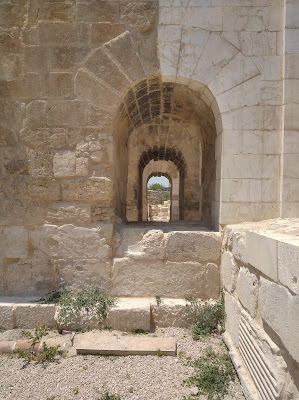Anazarbos was an ancient city in Cilicia located on and alongside an isolated range of hills, ca. 220 m high. It is not clear who and when founded the city. It is speculated that the Upper City was first inhabited by the Assyrians, and the Greeks gave a start to the Lower City. Local scholars claim that currently used name 'Anavarza' has its origin in the Persian word 'nezarba' meaning 'invincible'. The Persians had been present in Cilicia for some 200 years before the arrival of Alexander the Great in 333 BC. The city rose to prominence under the rule of Rome when it became the 2nd most important centre in the region after Tarsos.
 |
| Anazarbos * |
 |
| Landform (Google Earth) N↑ * |
The Roman triumphal arch at Anazarbos (B on plan) was erected in the late 2nd or early 3rd century AD upon a victory the Romans achieved against the Persians. The 14-meter-high and originally three-arched structure served later as the city's south gate. The arch underwent restoration works between 2018 and 2020 with a spectacular effect.
 |
| Looking from south * |
 |
| Looking from east * |
 |
| Looking from west * |
 |
| Structure offers some respite * |
 |
| Arch casts long shadow on double, colonnaded street (19 Jan) * |
 |
| So-called Church of the Apostles (C on plan); 5th c. AD; looking from southeast (19 Jan) * |
 |
| Church was built on basilica plan with stones of older structures (spolia); frieze (19 Jan) * |
 |
| Church remains seen from northwest (19 Jan) * |
 |
| Church of the Apostles and colonnaded street (after Posamentir, 2011) * |
 |
| Trench opened north of Church; looking from northeast (19 Jan) * |
 |
| Roman bench with fish-shaped armrest; looking from southwest (19 Jan) * |
 |
| Colonnaded street; looking from north (19 Jan)* |
 |
| Colonnaded street; 200-meter passage will be restored * |
 |
| Looking from north * |
 |
| Less decorative on inner side (19 Jan) * |
 |
| Architectural elements grouped immediately south of Arch (19 Jan) * |
 |
| Touristic facilities * |

